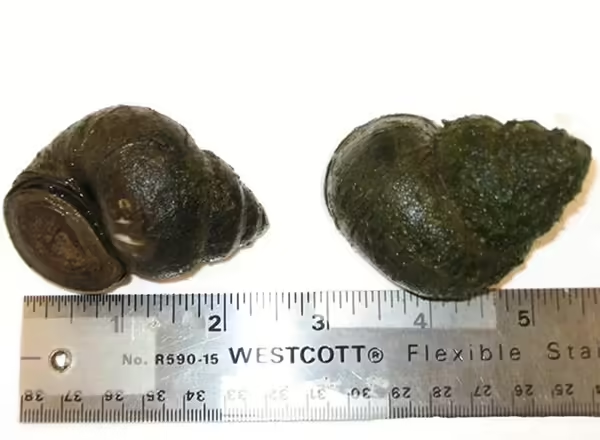
Chinese Mystery Snail
The Chinese mystery snail (Cipangopaludina chinensis), also known as Asian apple snail, Asian freshwater snail, and trapdoor snail, is found in Lake Michigan and competes with native snails, harm aquatic food webs and can clog water-intake pipes.

Chinese mystery snails compete with native snails for food and adversely affect aquatic food webs. The relatively large and thick shell may enable this species to easily evade predation, giving it an advantage over native species. They have the potential to act as a biotransfer of contaminants between polluted ecosystems and consumers. In its native range, the Chinese mystery snail was identified as a host for numerous parasites harmful to both human and animal consumers.
Chinese mystery snails can clog water-intake pipes and can die-off in large numbers, fouling beaches and shorelines.
Native to Southeast Asia, Japan, and eastern Russia, they were sold in food markets in San Francisco, California, in the late 1800s. By 1965, the species was established on both coasts. The Chinese mystery snail was first recorded in the Great Lakes basin in the Niagara River between 1931 and 1942. It is now established in Lake Ontario and Lake Michigan drainages.
Currently it can be introduced by being released from aquariums and bait buckets and can be moved when attached to recreational gear such as boats and fishing tackle.
Chinese mystery snail and its Regulation
It is currently unregulated in Illinois. It is classified as a restricted species in Wisconsin.

The Chinese mystery snail prefers soft, muddy, or sandy bottoms of shallow quiet waters. It can be identified by its smooth, relatively large, and coiled spiral shell. The shell is taller than it is wide and can be brown, greenish-brown, or reddish-brown in color. They grow up to 3 inches tall. The shell opening is on the right when the shell is pointed up. They have an operculum covering the opening, which is missing when the snail is dead and the shell is empty.
The Chinese mystery snail is similar to two other Great Lakes invasive species, the Japanese mystery snail and the banded mystery snail. The Chinese mystery snail is distinguished from the Japanese mystery snail by a more compressed shell and from the banded mystery snail by its lack of darkly-pigmented rings around the shell.
There is no known effective population control for Chinese mystery snails in waterbodies so agencies are focused on preventing introduction and spread.
Before you leave a body of water after boating or fishing, always remove, drain, and dry:
- REMOVE plants, animals, and mud from all equipment. Mud and plant fragments can also hide aquatic invasive species too small to be seen with the naked eye.
- DRAIN all water from your boat and gear. Boaters should ensure plugs are pulled from bilge and live wells before leaving a waterway. Bait bucket water should be drained on land.
- DRY everything thoroughly with a towel. All equipment that comes into contact with water should be wiped off and dried with quick-dry towel. If possible, dry everything for five days before entering new waters.
Clean other equipment as necessary. Waders and boots should be scrubbed and rinsed with tap or well water. If possible, use hot or high-pressure water to clean your equipment. Using a car wash for your boat and trailer is a great alternative. Full-strength white vinegar or a solution of ¼ cup bleach per gallon of water can be used to disinfect equipment and confined spaces like live wells.
- Smithsonian Environmental Research Center, Chinese mystery snail
- Great Lakes aquatic nonindigenous species information system
- Environmental Reviews, A review of the non-indigenous Chinese mystery snail, Cipangopaludina chinensis (Viviparidae), in North America, with emphasis on occurrence in Canada and the potential impact on indigenous aquatic species